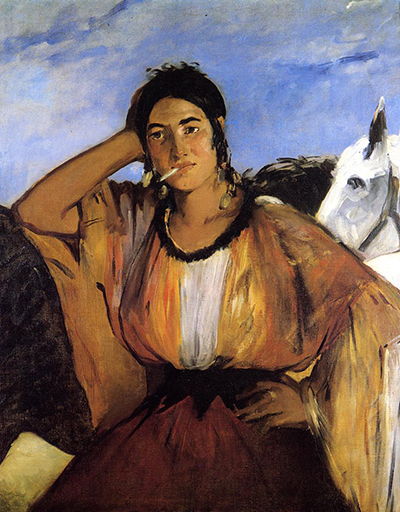Edouard Manet’s painting, Gypsy with a Cigarette, showcases a mixture of impressionism and realism, as both techniques are intertwined together.
The painting was found in Edouard Manet’s studio upon his death, however was never showcased at an exhibition. The original title of the piece had not been found, nor an exact date of completion. The piece was originally titled Indian Woman or Mexican Women, however has now been renamed to Gypsy with a Cigarette. Due to the similar Spaniard style Manet painted at the time, the origin of the painting is said to be around the 1870's.
Edouard Manet was fascinated at the time by Spanish culture and ideology. His Spanish colleagues, Velázquez and Goya, have significantly influenced his style, with everything from textures, brush strokes, and to content he painted. The model of the painting remains unknown, however is an exotic muse, compared to his classic paintings of French women. The woman within the painting carried a darker olive skin tone, with black hair. The model holds a cigarette between her lips as she posed against a horse. She is clothed in a multi-coloured dress, drenched in oranges, reds, yellows and whites.
The warmer shades accentuate her tanned skin, and orange lips. Signature Spanish details arise though black accents through the colour of her hair, eyes and eyebrows. As the woman leans against a black horse, a white one in the background accompanies it. A few art critics have suggested that the two opposite coloured horses are a symbol for French culture and Spanish culture. The white horse illustrates the traditional styles and culture of France, whereas the black horse is a symbol for the exotic Spanish culture. However as both are yet horses, it suggests the theme of the two nations coexisting together.
Manet's fascination for the Spanish culture had greatly impacted his work, with similar paintings such as The Dancer Mariano Camprubi, Young Man in Costume of a Majo, Mile Victorine in the Costume of an Espada, Young Man in Costume of a Toreador, and Young Woman Reclining in Spanish Costume. Also the pieces were painting during the same time period within the 1860’s and 1870’s, illustrating the new themes Manet was seized by. The artists had incorporated his attraction for the Spaniards as he illuminated the woman within the painting, beautifully leaning against the horse. It is unknown whether Manet had the woman to pose, or if he repainted a memory he carried through the years.




